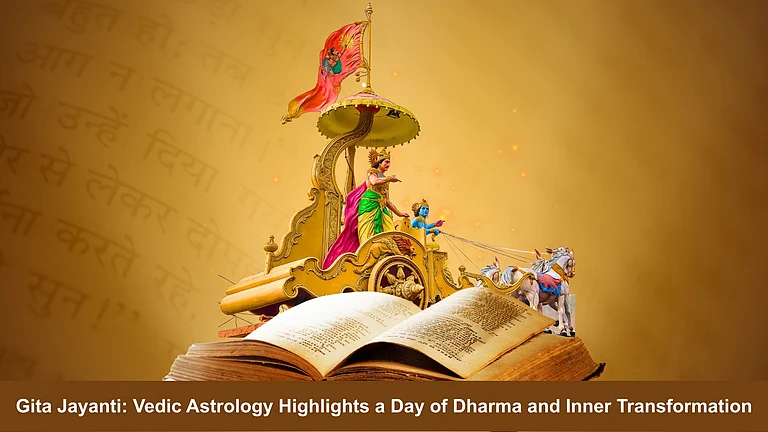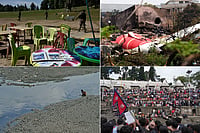Janmashtami, also known as Gokulashtami, marks the birth of Lord Krishna and is celebrated across India with immense devotion, enthusiasm, and joy. Homes and temples are decorated with flowers and lights, devotional songs fill the air, and the birth of the beloved deity is commemorated at midnight. A key element of this festival is the offering of bhog – a variety of traditional dishes lovingly prepared and offered to Lord Krishna before being distributed as prasad to devotees.
One of the most endearing aspects of Krishna’s legend is his love for Makhan (butter) and dahi (curd). Referred to fondly as Makhan Chor (the butter thief), Krishna’s mischievous childhood stories are fondly remembered and recreated during Janmashtami. To honour him, devotees often prepare 56 bhog (chappan bhog), a grand assortment of 56 food items. However, if preparing the full 56 is too much, here are five traditional and simple bhog dishes you can prepare at home to offer your devotion and love.
1. Makhan Mishri

Makhan Mishri is the most iconic and beloved dish of Lord Krishna. It is a humble yet spiritually significant offering made with fresh white butter (makhan) and rock sugar crystals (mishri). This dish recalls the divine stories of young Krishna stealing butter from clay pots in Gokul.
To prepare Makhan Mishri, churn fresh cream until the butter separates. Once the butter is ready, rinse it in cold water and gently mix it with rock sugar or powdered sugar. For a traditional presentation, serve it in small earthen pots or clay bowls. This dish not only honours Krishna’s love for dairy but also symbolizes purity, devotion, and the joy of simplicity.
2. Panchamrit

Panchamrit is an essential offering in any Krishna puja. The word ‘Panchamrit’ means "five nectars" and refers to a sacred mixture of five ingredients: milk, curd, honey, ghee, and sugar. This holy mixture is used in abhishek (ritual bathing of the deity) and then distributed as prasad.
Each ingredient of Panchamrit carries spiritual significance. Milk symbolizes purity, curd signifies prosperity, honey represents sweetness in speech, ghee stands for strength, and sugar denotes bliss. You can enhance the flavour by adding tulsi leaves and a few drops of Gangajal (holy water), making it even more sacred. Panchamrit is not just food; it’s an elixir symbolising divinity and devotion.
3. Kheer (Rice Pudding)

Kheer, a creamy and aromatic rice pudding, is a staple offering during most Hindu festivals, including Janmashtami. Made with rice, milk, and sugar, and flavoured with cardamom, saffron, and dry fruits, this sweet dish is considered highly auspicious.
To prepare kheer, simmer milk until it thickens, add soaked rice, and cook on low heat until the grains are soft. Stir in sugar, cardamom powder, chopped almonds, cashews, and raisins. Garnish with saffron strands and serve either warm or chilled. Kheer’s rich texture and divine aroma make it a favourite offering that embodies warmth, abundance, and love.
4. Makhana Paag

Makhana Paag is a traditional sweet made from fox nuts (makhana) and jaggery or sugar. Crunchy and mildly sweet, this dish is a delightful addition to the Janmashtami bhog platter. In several parts of North India, particularly in Mathura and Vrindavan, Makhana Paag is a must-have offering to Lord Krishna.
To make this, roast makhana in a little ghee until they become crisp. In a separate pan, prepare sugar or jaggery syrup (paag) and mix the roasted makhanas in it until they are evenly coated. Once cooled, the syrup crystallizes, giving the fox nuts a crunchy coating. It’s a nutritious and symbolic dish that reflects Krishna’s love for wholesome village food.
5. Poha with Curds and Jaggery (Dahi Chura)

Dahi Chura, or beaten rice with curds and jaggery, is another simple yet traditional preparation often made as Krishna’s bhog, especially in Bihar and eastern parts of India. Legend has it that Krishna enjoyed poha served with creamy dahi, and devotees recreate this comforting dish with love.
To prepare, rinse the poha lightly and let it soften. In a bowl, mix it with thick curd, a pinch of cardamom, and jaggery. You can also add sliced bananas or grated coconut for added richness. This humble and wholesome dish represents the down-to-earth nature of Krishna and his deep connection to the rural and agrarian roots of Indian society.
Final Thoughts
Janmashtami is not just about grand rituals and celebrations but about offering pure love and heartfelt devotion to Lord Krishna. The bhog you prepare is not measured by its quantity or extravagance but by the intention and love with which it is made.
These five traditional dishes, Makhan Mishri, Panchamrit, Kheer, Makhana Paag, and Dahi Chura, capture the essence of Lord Krishna’s favourite foods and the cultural heritage of India. Simple to prepare, these bhog items are deeply rooted in devotion and offer a meaningful way to celebrate the divine spirit of Krishna.
As you chant “Vasudev Sutam Devam,” light the diya, and place your bhog before the idol of Kanha this Janmashtami, remember that the real essence of celebration lies in the joy of giving, the sweetness of shared prasad, and the power of unwavering faith.
Happy Janmashtami! May Lord Krishna shower your home with love, laughter, and prosperity.



























